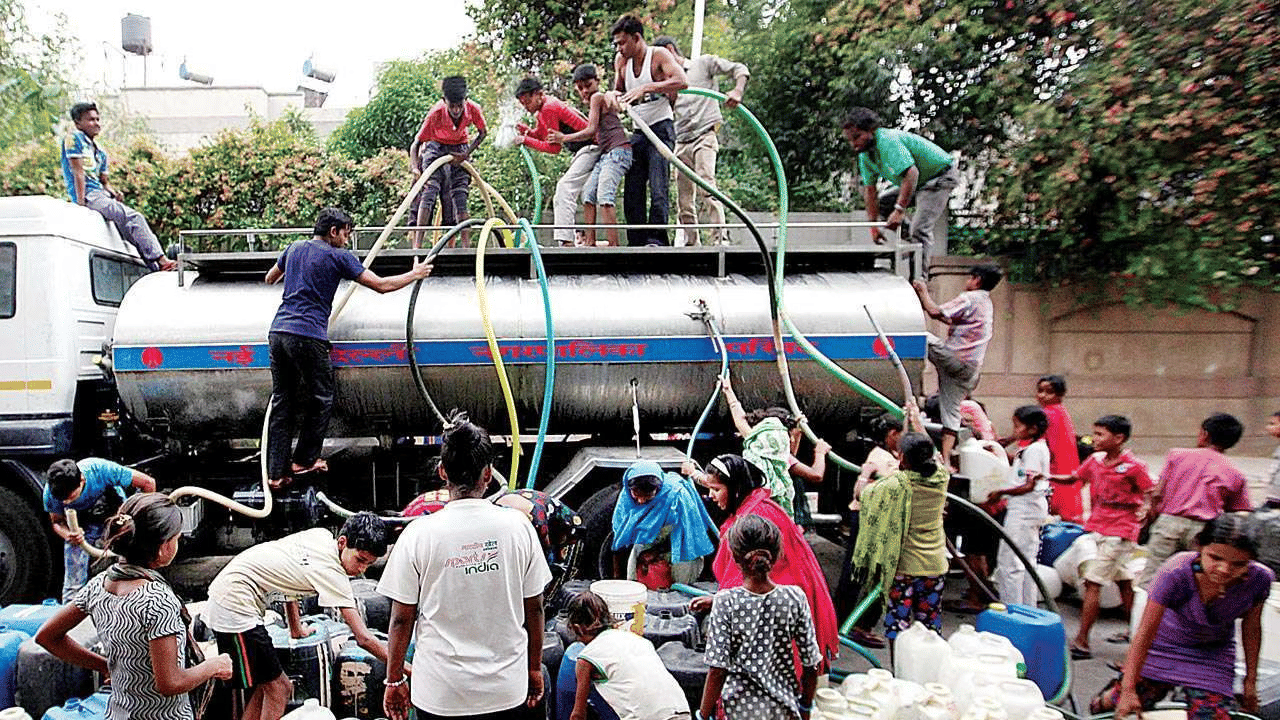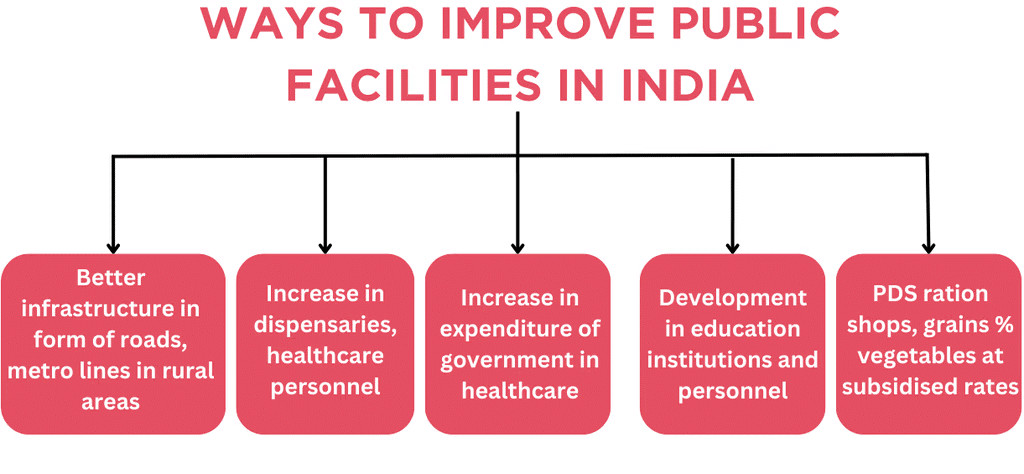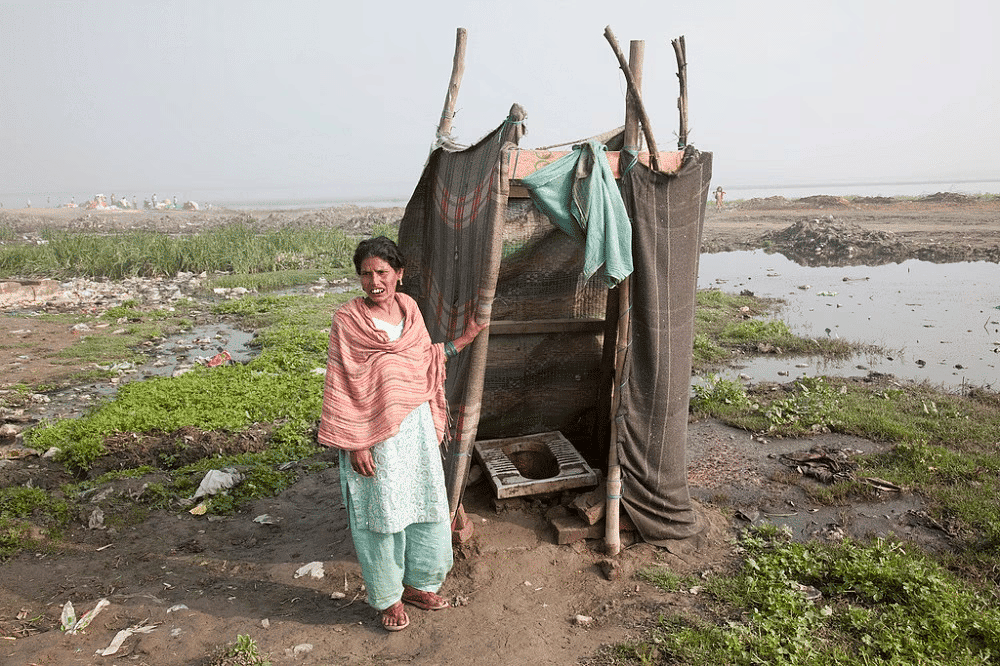NCERT Summary: Public Facilities | Indian Polity for UPSC CSE PDF Download
Introduction
Government-provided amenities, known as public facilities, play a crucial role in enhancing the quality of life and ensuring the well-being of the populace. These services are essential for maintaining a comfortable and sustainable lifestyle.

- In India, public facilities like water supply, healthcare, and education are essential for living a good life, as recognized by the Indian Constitution.
- This chapter looks at how important these services are for making sure everyone has fair access to the basic resources needed for a decent life.
Water and the People of Chennai
- Mr. Ramgopal resides in Anna Nagar, Chennai, an area adorned with vibrant greenery and well-maintained lawns, thanks to the generous use of water.
- Conversely, in the apartment of Mr. Subramaniam, water supply is insufficient, necessitating an expenditure of Rs 500-600 monthly to procure water.
 Water Collection
Water Collection
- In Madipakkam, Chennai, Siva encounters a water supply that arrives only once every four days. To meet her drinking water needs, she resorts to purchasing bottled water. The availability of water as a public utility varies significantly among individuals.
- Padma's Experience: Works in Saidapet, lives in a slum with inadequate water facilities, pays Rs 650 rent for a hutment with no tap connection; relies on a common tap for limited water twice daily, which is used for both washing and drinking. In summer, water availability becomes even more restricted, causing long waits for tankers.
- The provision of safe drinking water is deemed a fundamental right for every individual, and it is incumbent upon the government to ensure its accessibility to all citizens.
Water as Part of the Fundamental Rights to Life
- Water is indispensable for sustaining life and promoting good health.
- Unfortunately, India grapples with a substantial burden of water-related diseases, including diarrhea, dysentery, and cholera, contributing to a daily toll of over 1600 lives, predominantly among children under the age of five.
- Acknowledging the fundamental importance of water, the Constitution of India recognizes the right to water as an integral facet of the Right to Life encapsulated under Article 21. This entails the imperative of ensuring "universal access" to water.
- Decisions handed down by both High Courts and the Supreme Court affirm the status of the right to safe drinking water as a Fundamental Right.
- 2007 Case: Andhra Pradesh High Court addressed water contamination from a textile company, directing the district collector to provide 25 litres of water per person to the affected village.
- In the legal realm, these court rulings underscore the government's responsibility to guarantee a consistent supply of fresh drinking water to the populace.

Public Facilities
- Essential elements for survival, such as electricity, public transport, schools, and colleges, collectively referred to as public facilities, are vital for societal well-being.
- These amenities are designed to be accessible to a wide cross-section of the population, emphasizing the idea of shared benefits.
- It is incumbent upon the government to ensure the availability of public facilities to every individual.
- Discrimination based on social or economic divisions should not be tolerated, as the responsibility lies with the government to provide equal access to these essential services for all.
The Government’s Role
- Government Responsibility: A fundamental responsibility of the government is to ensure widespread access to essential public facilities, encompassing the establishment of educational institutions, improvement of health and sanitation services, equitable distribution of food, enhancement of transportation infrastructure, and maintenance of crucial public utilities like post offices, railways, and roads.
- Private Sector: While private companies operate in pursuit of profit within the market, public facilities are directly linked to fulfilling people's basic needs.
- Private Services: While private companies might provide some public services (e.g., schools, hospitals) and water supply, these services are often expensive and not accessible to everyone, particularly lower-income individuals.
- Funding: The government relies on tax revenue collected from the populace to fund these programs, utilizing these financial resources for activities such as supplying water.

- Costs: This involves incurring costs for pumping, long-distance transportation, laying down distribution pipelines, water treatment, and the collection and treatment of wastewater.
- Constitutional Right: The Right to Life under the Indian Constitution includes access to essential public services, implying that the government must ensure these services are provided universally and affordably to uphold equality and protect basic rights.
- To make resources available to everyone, a key governmental role is to implement strict administration and effectively execute welfare schemes, especially benefiting the underprivileged.
- Emphasize that the government’s role includes ensuring that essential public services are available to all citizens, including the underprivileged.
- Examples of Government Services: Include specific examples like the maintenance of drains, anti-malaria campaigns, and the provision of clean drinking water as key responsibilities of the government.
- By judiciously utilizing the revenue generated, the government can contribute to social welfare initiatives and ensure optimal well-being for the majority of the population.
 Water Supply Protection
Water Supply Protection
Where Does the Government Get Money for Public Facilities?
Government Budget:
- Each year, the government presents a budget in Parliament, detailing past expenses and future spending plans.
Revenue Sources:
- Taxes: The primary revenue source is taxes collected from the public, which the government uses to fund various programs and services.
- Charges for Services: Additional revenue comes from fees for public services, such as water.
Example: Water Supply Funding:
- Expenses: Costs include pumping, transporting, treating water, and managing wastewater.
- Funding: These costs are covered partly by taxes and partly by charging for water, with prices set to ensure affordability for daily use.
Water supply to Chennai: Is it Available to All?
- Chennai grapples with a noticeable deficiency in water supply, where the municipal provision typically fulfills only approximately half of the city's collective needs.
- The brunt of these inadequacies disproportionately affects the economically disadvantaged segments of the population.
- This challenge of scarcity and heightened crisis, particularly during the summer months, is a shared reality in numerous other cities across India.
- Shortcomings in municipal water supply are often perceived as indicative of government shortcomings, with the burden of insufficiencies notably impacting the less privileged.

- Globally, the responsibility for water supply predominantly rests with governments, with private sector involvement in water supply being a rare occurrence.
- Amidst the backdrop of industrialization, water pollution has emerged as a significant concern.
- Addressing this issue and ensuring access to clean drinking water for a large populace necessitate technological advancements, which, in turn, require government investments.
- In this contemporary era, achieving widespread availability of clean drinking water is contingent upon strategic government initiatives leveraging technological progress.
Taking water from Farmers
- Water scarcity leads to increased privatization.
- Private companies sourcing water from areas surrounding cities like Chennai.
- Chennai's water supply is sourced from towns and villages north of the city.
- Over 13,000 water tankers are used for transportation.
- Monthly payments to farmers for water rights affecting agriculture and local drinking water.
- Significant decline in groundwater levels in impacted areas.
In Search of Alternatives
- The shortage of municipal water and acute crisis during summer months are common in other cities of India, not just Chennai.
- Private companies are filling the gap in water supply and selling water for profit.
- There are great inequalities in water use, with people in slums having to make do with less than 20 litres per day, while those in luxury hotels may consume as much as 1,600 litres per day.
 Slums
Slums
- Some argue that the government's inability to supply enough water and the financial losses of municipal water departments indicate a failure, and suggest that private companies should take over water supply.
- However, there are instances worldwide where water supply is a function of the government, and areas where public water supply has achieved universal access.
- In some cases where water supply was handed over to private companies, there was a steep rise in the price of water, leading to protests and riots.
- Indian Examples:
- Mumbai: The water supply department covers its expenses through water charges.
- Hyderabad: Improved coverage and revenue collection by the water department.
- Chennai: The government water department has initiatives like rainwater harvesting and uses private companies for transportation and distribution. However, the government sets rates and regulates these private services through contracts.
Public Water Supply in Porto Alegre
- Porto Alegre in Brazil ensures universal access to safe water, leading to low infant mortality rates.
- Water prices are kept affordable, with the poor charged at a discounted rate.
- Profits from the water department are reinvested to enhance water supply.
- The department operates transparently, allowing public involvement in project decisions.
- Public meetings enable citizens to voice opinions and vote on priorities.
Extending Sanitation Facilities
- Besides clean drinking water, sanitation is crucial to prevent water-borne diseases.
- In India, sanitation coverage is lower than water coverage.
- 87% of Indian households have access to drinking water, while only about 53% have access to sanitation.
- The poor in both rural and urban areas face challenges in accessing sanitation facilities.
- Sulabh, an NGO, has addressed sanitation issues for low-caste, low-income individuals in India for nearly five decades.
- Sulabh has built over 8,500 community toilet blocks and 1.5 million household toilets, benefiting 20 million people.
- Most users of Sulabh facilities are from the poor working class.
- Sulabh collaborates with municipalities to construct toilet blocks using government funds.
- Local authorities provide land and funds for the services, while maintenance costs are covered by user charges in some cases.
Conclusion
- Public facilities, essential for our basic needs, are constitutionally recognized in India, with rights to water, health, education, and more acknowledged as integral components of the Right to Life. The primary responsibility of the government lies in ensuring widespread access to sufficient public facilities.
- Universal access to public amenities not only enhances living standards but also contributes to a nation's international recognition in terms of development. The effectiveness of any government is gauged by its ability to provide essential facilities and meet the basic needs of every individual.
- Ultimately, these facilities serve as the foundational elements for the overall development of a nation.
|
145 videos|630 docs|203 tests
|
FAQs on NCERT Summary: Public Facilities - Indian Polity for UPSC CSE
| 1. What is the significance of water for the people of Chennai? |  |
| 2. How does access to water relate to the fundamental rights to life? |  |
| 3. What role does the government play in providing water supply to Chennai? |  |
| 4. Are public facilities for water supply available to all residents of Chennai? |  |
| 5. What alternatives exist for water supply in Chennai, especially for underserved communities? |  |

|
Explore Courses for UPSC exam
|

|

















